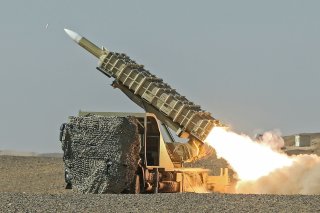The Next Refugee Crisis That Could Dwarf Ukraine
European leaders may believe they have reached capacity after successive waves of Syrian and now Ukrainian refugees, but, in Iran, a far greater wave may loom on the horizon.
Ukrainian refugees continue to flee from Russia’s onslaught, but as in Syria, the flows are not random. Russian president Vladimir Putin, like his Syrian counterpart Bashar al-Assad, has deliberately targeted civilians to encourage a flight that he can use to pressure Europe for concessions. According to the United Nations, the Ukraine war has already created more than three million refugees, and that data seems not to include those who have fled eastward into Armenia and Central Asia where costs-of-living are considerably cheaper. That has catapulted Ukraine, in a matter of weeks, to one of the world’s top refugee-generating countries, after Syria and Venezuela.
Ukraine might not hold that distinction for long. Syria has a population of 17.5 million; Venezuela’s is 28.4 million; Ukraine’s is 44.1 million. Iran’s population, however, is nearly double Ukraine’s, and instability is on the horizon.
Regime change is coming to Iran, not because of the outside world but simply because Supreme Leader Ali Khamenei is old and mortal. While speculation is rife that Khamenei stage-managed Ebrahim Raisi’s rise to the presidency in order to ease the way to his succession, a smooth transfer of power is far from certain. Khamenei neither has the religious credentials nor charisma that his predecessor, Ayatollah Ruhollah Khomeini, had; his word will no longer be meaningful after his death.
Complicating succession further is just how lucrative the position has become. Khamenei is corrupt. During his thirty-three-year tenure, Khamenei accumulated billions of dollars through the business interests he controls. To rise to Iran’s leadership is not only to wield vast power unencumbered by the constraints of democracy (the supreme leader stands above and apart from all elected positions in Iran) but also vast wealth. Given how seldom transitions occur—Khamenei’s passing will mark the second transition in more than forty-three years—there is no incentive to wait patiently. Rather, any figure with ambition will make his move and join the destabilizing scrum.
The Islamic Revolutionary Guard Corps (IRGC) will also join the melee. In 1989, various Iranian power centers compromised on Khamenei precisely because he was weak. Khamenei compensated for the lack of political base by establishing a symbiotic relationship with the IRGC: He would resist any meaningful constraints on its power, and it would support him as he consolidated control over political rivals. The IRGC, which has also enriched itself to the tune of hundreds of billions of dollars over Khamenei’s rule, will not be willing to return to the barracks, nor will it risk a political fight with a new supreme leader; rather, the IRGC will try to prevent anyone whom it does not dominate from reaching the leadership.
The fight might be brutal. Whenever there has been a leadership vacuum in Iran, military forces have concentrated in the capital allowing restive tribes and political groups along the country’s periphery to fill the vacuum. Neighboring countries seldom resist involving themselves in the melee. This was the context of the 1946 Azerbaijan Crisis, the first real crisis of the Cold War, as the Soviet Union sought advantage from Iran’s weakness in the years after both the country’s occupation and the shah’s 1941 ouster. When Khamenei dies, it is reasonable to expect that not only Russia, but also Iraqi Kurds, Turks, Saudis, Israelis, and Pakistanis will all support proxy groups along Iran’s periphery if not in Tehran.
Any civil war will devastate civilians, but as the Revolutionary Guards or other hardline factions seek to consolidate control, they might choose to target civilians. Consider Iraq in the immediate aftermath of the U.S. invasion: The militias surrounding Shiite firebrand Muqtada al-Sadr actively targeted the educated and middle classes across the sectarian spectrum for the simple reason that such people would never support Sadr. Western diplomats lament a brain drain but, for certain political constituencies unwilling to compete on a political and intellectual level, such a flight is a positive development. Iran’s growing protest movement suggests many Iranians if not most hope for an end to the Islamic Republic. It will be in the interests of diehard proponents of Khomeini’s failed experiment to drive these Iranians from the country as they are no longer able to convince them that the Islamic Republic is anything more than a cynical dictatorship in clerical garb.
Iran’s looming economic troubles may also contribute to a perfect storm. Neither sanctions nor Covid-19 fully explain Iran’s economic woes. According to the Central Bank of Iran, net capital stock, the best measures of an economy’s trajectory—fell into negative territory even before President Donald Trump withdrew from the Joint Comprehensive Plan of Action and Secretary of State Mike Pompeo implemented a “Maximum Pressure” campaign against the Islamic Republic’s economy. This points to a fundamental weakness in the economy that the infusion of several billion dollars was unable to reverse. Quite simply, Khamenei’s stewardship of the Iranian economy has run it into the ground. Iran faces economic collapse.
Upheaval inside Iran could generate more than ten million refugees. Few would choose to go east to Afghanistan and, as with Syrian refugees, the Arab world will be unwilling to take them. This means a large refugee flow northward into the Caucasus and then west through Turkey toward Europe. European leaders may believe they have reached capacity after successive waves of Syrian and now Ukrainian refugees, but a far greater wave may loom on the horizon.
Michael Rubin is a senior fellow at the American Enterprise Institute.
Image: Reuters.

